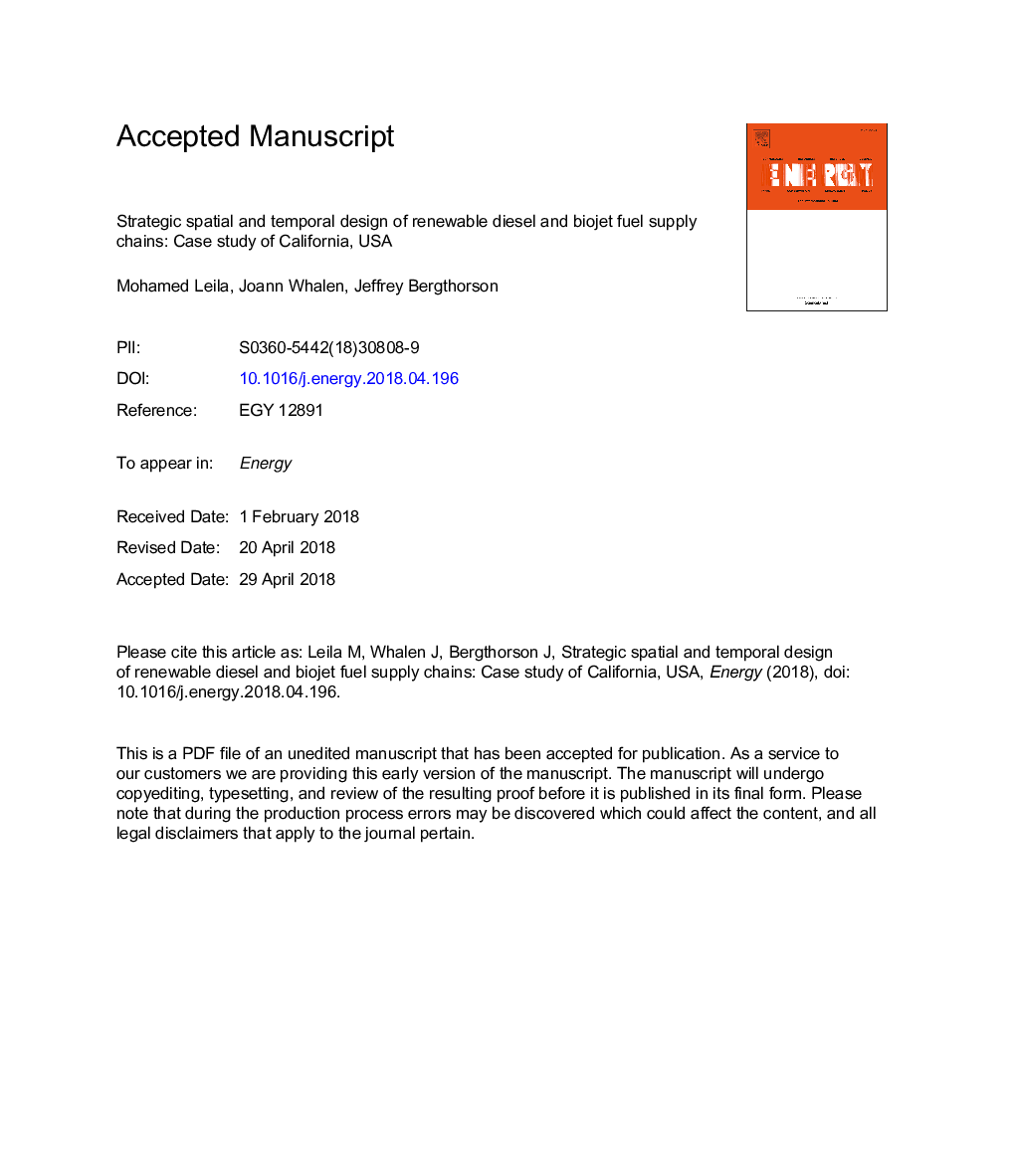| کد مقاله | کد نشریه | سال انتشار | مقاله انگلیسی | نسخه تمام متن |
|---|---|---|---|---|
| 8071335 | 1521394 | 2018 | 41 صفحه PDF | دانلود رایگان |
عنوان انگلیسی مقاله ISI
Strategic spatial and temporal design of renewable diesel and biojet fuel supply chains: Case study of California, USA
ترجمه فارسی عنوان
طراحی فضایی و زمانی استراتژیک زنجیره های تامین سوخت دیزل و بیوگرافی تجدید پذیر: مطالعه موردی کالیفرنیا، ایالات متحده آمریکا
دانلود مقاله + سفارش ترجمه
دانلود مقاله ISI انگلیسی
رایگان برای ایرانیان
کلمات کلیدی
برنامه ریزی خطی مختلط عدد صحیح، سوخت های زیستی نظامی، بهینه سازی زنجیره تامین، بهینه سازی اسپکتیو-زمان، فیشر ترپش، هیدرولیک استرها و اسیدهای چرب،
موضوعات مرتبط
مهندسی و علوم پایه
مهندسی انرژی
انرژی (عمومی)
چکیده انگلیسی
The United States (US) military plans to acquire drop-in biofuels (renewable diesel and biojet fuel) to reduce carbon emissions and diversify military energy portfolio. To expedite this endeavor, the military provided direct financial incentives to offset investment costs of selected drop-in biofuel demonstration facilities. It is not known if investment incentives alone will stimulate the creation of a full-scale advanced biofuel supply chain capable of meeting US military demands, given limited availability of low-cost sustainable biomass feedstocks in some areas and considering the uncertainty in global oil prices. The objective of this work is to determine 1) whether a state in the US can meet its share of military biofuel targets from local biomass resources, and 2) if direct financial incentives can expedite the development of the military biofuel supply chain, under two different oil price scenarios. The Biofuel supply chain GeoSpatial and Temporal Optimizer (BioGeSTO), was developed for that purpose and applied to the state of California, USA from 2020 to 2040. The BioGeSTO model determined that biomass resources in California can meet 12-19% of its annual military targets between 2020 and 2040 of renewable diesel and biojet fuel using the Fischer-Tropsch (FT) and Hydro-Treatment of Esters and Fatty Acids (HEFA) conversion technologies. However, under the reference oil price scenario, only HEFA conversion facilities introduced at 2027 in Kings County were found feasible. Under the high oil price scenario, both the HEFA and FT technologies were financially feasible and the supply chain production approaches the theoretical production limit by 2032. In both scenarios, providing investment incentives has a modest impact on expediting the supply chain, as facilities are introduced only 1-3 years earlier when receiving direct investment incentives. Sensitivity analysis shows that biomass availability has the greatest impact on the supply chain performance such that a 50% increase in the baseline amount of biomass feedstock results in a 150% surge in the total cumulative production. In conclusion, the reference oil price scenario drastically limits the ability of California to meet its military drop-in biofuel targets. Assuming a high oil price scenario, the state may be able to meet military biofuel targets by subsidizing local biomass production and importing the rest of the biomass required for this purpose from the northwestern states of Washington and Oregon.
ناشر
Database: Elsevier - ScienceDirect (ساینس دایرکت)
Journal: Energy - Volume 156, 1 August 2018, Pages 181-195
Journal: Energy - Volume 156, 1 August 2018, Pages 181-195
نویسندگان
Mohamed Leila, Joann Whalen, Jeffrey Bergthorson,
